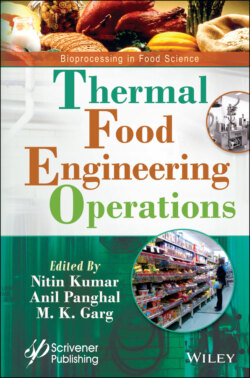Читать книгу Thermal Food Engineering Operations - NITIN KUMAR - Страница 54
2.6.5 Ohmic Heating 2.6.5.1 Principle and Mechanism
ОглавлениеThe traditional method of heat processes like pasteurization and sterilization follows conduction and conduction methods to injure the microorganisms and reducing the load. As mentioned earlier, these methods also consume much time and energy. To mend these disadvantages and meet the demand of the food and increase the quality of the food ohmic heating is also one of the techniques used for better inactivation methods of microbes [78]. Other names of ohmic heating, electro heating, or joules heating, have gained much interest in the food industry. Any conductive food when heat is passed from within, heat is straightaway produced and simultaneously temperature is increased. This technique is utilized for power products, fruits, and vegetables. The pattern in which heat is generated during ohmic heating causes food products to heat up rapidly in a uniform manner [79]. Overheating is avoided of any food product in this situation as there is not much temperature change or gradient. Therefore this technique consumes less heat and also increases the shelf life of the sample as compared to the traditional method.
The major process in this method is the thermal effect which is used for the destruction of the cellular structure of the microbes. With this thermal effect, an additional effect added to the mechanism is the chemical effect which helps in free oxygen and hydrogen formation [80]. It also produces radicles of hydroperoxyl and metal ions. Injury of microbes is usually due to the buffer solution used which makes the solution or the product toxic. This toxic formation is the main principle agent to cause the deactivation of microorganisms, and later after the desired state is achieved, toxicity also reduces gradually [81].
When compared to the traditional water bath and ohmic shows a better death effect which is created by electric current. The heating is performed under similar temperature and time parameters. During this process, the permeability of the cell is higher whereas transudation of intracellular materials is also elevated which eventually leads to cell injury of the microorganisms [82]. Cell permeability depends upon several factors such as electric current, increased frequency, and higher potential of threshold, processing time. These factors play a vital role in progressing the inactivation process.
The augmented permeability might cause irreversible damage to the cell over seepage of cellular compounds, together with proteins, enzymes, amino acids, and nucleic acids. But some studies have also stated that the electroporation method has a specialized effect on the cellular and intracellular effect [83]. Eventually, this can be maintained by fluctuating the parameters so that leakage doesn’t happen beyond the threshold level which automatically leads to death. A connection is formed between thermal and chemical effects because the heat is generated due to the generation of electric current passing through the sample of food [84]. In ohmic heating, with temperature, the heating rate also increases. So it is necessary to carefully experiment and design to match the conditions for thermal and chemical effect. Consequently, there will be an extended method to explain the thermal properties owing to the spirit of ohmic heating where heat is formed due to electric current.
